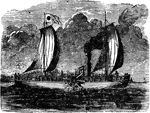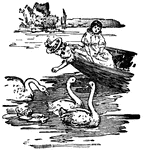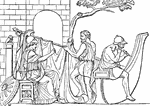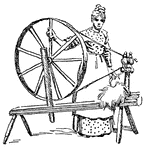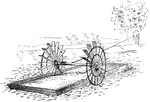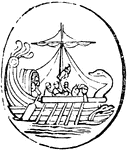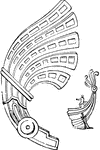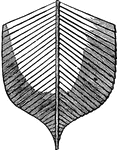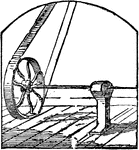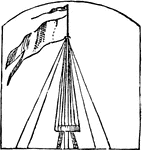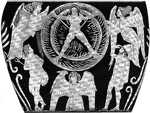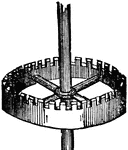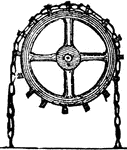Electric Torpedo Boat
"Torpedo Boats are small vessels built for speed and fitted with tubes for firing torpedoes by either…
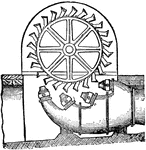
Pelton Wheel Turbine
"Turbine is, in mechanics, a term formerly confined to horizontal water wheels, the revolution of which…
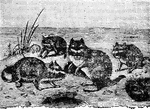
Viscacha
"Viscacha is a stout-built rodent, resembling a marmot, from 18 inches to two feet long, exclusive of…

Rhizostoma cuvieri
"The Rhisostoma Cuvieri, a British species, measures two feet, or ever more, in diameter, while…
Ulna and Radius
"The ulna, or elbow bone, is the larger of these two bones. It is joined to the humerus by…

Knots and Splices
"Knots and splices include all the various methods of tying, fastening, and joining ropes or cords.…
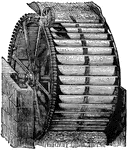
Overshot Wheel
"The Overshot wheel is a form of water wheel in which the water flows upon or near the top of the wheel.…

Rose Window
"A Rose Window is a circular window, divided into compartments by mullions and tracery radiating from…
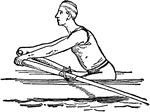
Positions in Rowing
"Rowing is the propulsion of a boat by oars. The oarsman sits with his face to the stern of the boat,…
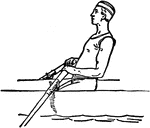
Positions in Rowing
"Rowing is the propulsion of a boat by oars. The oarsman sits with his face to the stern of the boat,…
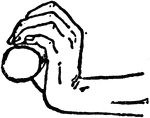
Wrist Positions in Rowing
"Rowing is the propulsion of a boat by oars. The oarsman sits with his face to the stern of the boat,…
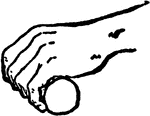
Wrist Positions in Rowing
"Rowing is the propulsion of a boat by oars. The oarsman sits with his face to the stern of the boat,…

Steamboat of 1736
"A steamboat is a boat or vessel propelled by steam acting either on paddles or on a screw. The term…
American River Steamboat
"A steamboat is a boat or vessel propelled by steam acting either on paddles or on a screw. The term…

Modern Sound Propeller
"A steamboat is a boat or vessel propelled by steam acting either on paddles or on a screw. The term…

Modern Ocean Steamship
"A steamboat is a boat or vessel propelled by steam acting either on paddles or on a screw. The term…
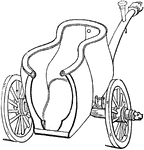
Currus
"A chariot, a car. These terms appear to have denoted those two wheeled vehicles for the carriage of…

Currus
"A chariot, a car. These terms appear to have denoted those two wheeled vehicles for the carriage of…
Submarine Boat
"A Submarine Boat is a boat capable of being propelled under the water. The first was probably that…
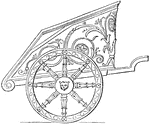
Chariot
"Arms and a chariot are here assigned to June through not properly a warlike goddess. The idea itself,…
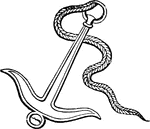
Anchor
The anchor used by the ancients was for the most part made of iron and its form... resembled that of…

Plaustrum
"A cart or wagon. It had commonly two wheels, but sometimes four, and it was then called the plaustrum…
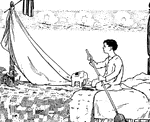
Bed Is A Boat
My bed is like a little boat; Nurse helps me in when I embark; She girds me in my sailors coat and starts…
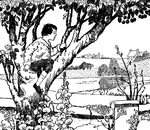
Foreign Lands
Up into the cherry tree, who should climb but little me? I held the trunk with both my hands and looked…
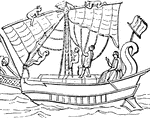
Greek Boat
"The masts were usually taken down when the vessel arrived in port, and raised again when it was about…
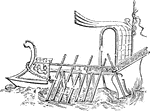
Ship with rudder
"The following cut represents a ship with its rudder. The pole by which it is fastened to the ship's…

Map measurer
"By use of an instrument called a map measurer, set the hand on the face to read zero, roll the small…

Two Egyptian Boats
"Two boats moored to the bank of the river by ropes and stakes. In the cabin of one, a man inflicts…

Spur
An instrument having a little wheel, with sharp points, worn on a horseman's heels, to prick a horse…

Cam-wheel
A wheel or part of a wheel, or irregular outline, employed to produce a variable or alternating motion…

Cutter
A vessel rigged nearly like a sloop, with one mast and a straight running bowspirit, which may be run…

Pulley
A wheel for transmitting power from, or imparting it to the different parts of machinery, or for changing…

Ratchet
A bar or piece of mechanism turning at one end upon a pivot, while the other end falls into the teeth…
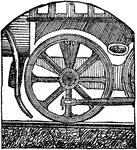
Driving-wheel
A wheel that communicates motion; the wheel of a locomotive, which, adhering to the track, communicates…

